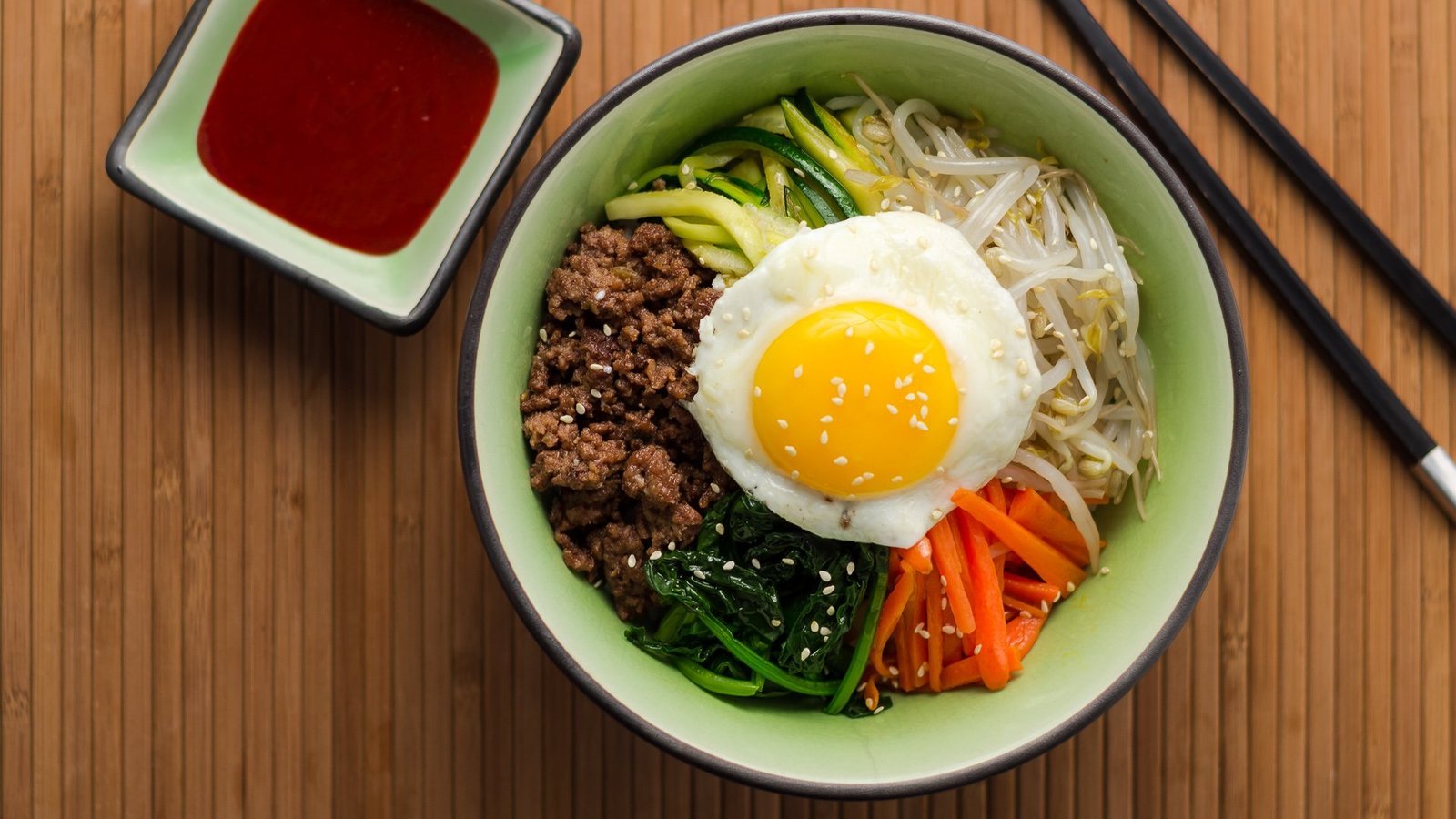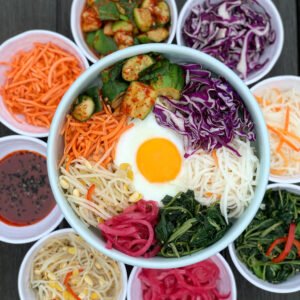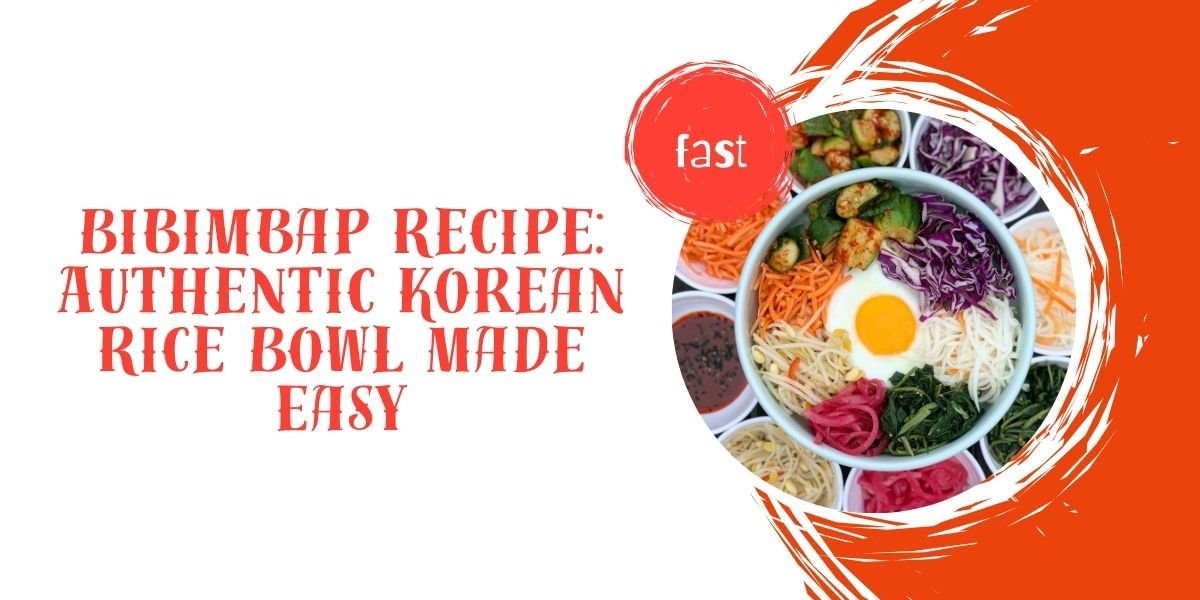Authentic Bibimbap Recipe: A Taste of Korea Iconic Dish
If you ever wanted to experience the authentic taste of Korean cuisine, this bibimbap recipe is your gateway to a delightful culinary journey. Bibimbap, a colorful and flavorful rice dish, is more than just a meal it an art form that combines perfectly cooked rice, fresh vegetables, savory protein, and a bold bibimbap sauce that ties everything together.
Whether you looking for an easy bibimbap recipe to make at home or want to learn the secrets of crafting the perfect Korean rice bowl, this guide has everything you need.
What Makes Bibimbap Special?
Bibimbap, which translates to “mixed rice,” is one of the most beloved dishes in Korean cuisine. It a dish that combines simplicity with versatility, offering endless variations to suit every taste. From bulgogi bibimbap featuring marinated beef to vegetarian or vegan versions, there a bibimbap for everyone.
The key to a great bibimbap is balance. Each element—rice, vegetables, protein, and sauce—works in harmony, creating a dish that as nutritious as it is delicious. This authentic bibimbap recipe will show you how to recreate this iconic Korean food in your own kitchen.
Ingredients You Need
To make this healthy Korean rice bowl, gather the following ingredients:
- Cooked short-grain rice (2 cups) as the base of your dish.
- Fresh vegetables like spinach, carrots, zucchini, and bean sprouts, all lightly cooked for a balance of texture.
- Protein options like bulgogi beef, pork bibimbap variations, or even tofu for a plant-based twist.
- A fried egg (optional) for added richness.
- The all-important bibimbap sauce, made with gochujang (Korean chili paste), sesame oil, garlic, and a touch of sweetness.
Each ingredient contributes to the vibrant appearance and rich flavors that make bibimbap a standout dish in Korean cuisine.

Step-by-Step Bibimbap Recipe
1. Cook the Rice
Begin with perfectly steamed short-grain rice. Its sticky texture is ideal for creating the base of this authentic Korean dish.
2. Prepare the Vegetables
Blanch spinach and season it lightly with sesame oil and salt. Sauté julienned carrots and zucchini until tender, and steam bean sprouts until soft. For a savory touch, cook shiitake mushrooms with a drizzle of soy sauce.
3. Cook the Protein
For a classic touch, prepare bulgogi beef or another protein like pork or chicken. Marinate the meat with soy sauce, garlic, sesame oil, and sugar for a rich, caramelized flavor.
4. Mix the Bibimbap Sauce
The sauce is the heart of this dish. Combine gochujang, sesame oil, rice vinegar, sugar, and garlic to create a bold, tangy flavor that elevates every bite of this easy bibimbap recipe.
5. Assemble the Dish
In a large bowl, start with a layer of rice. Arrange the vegetables, mushrooms, and protein in colorful sections around the bowl. Add a fried egg on top for an authentic touch.
6. Add the Sauce and Mix
Drizzle the sauce generously over the toppings. Before eating, mix everything thoroughly to combine the textures and flavors.
Tips for the Best Bibimbap
- Use Fresh Ingredients: The quality of your vegetables and protein directly impacts the taste of this healthy Korean rice bowl.
- Customize Your Protein: This recipe works beautifully with variations like pork bibimbap or tofu for a vegetarian option.
- Perfect the Sauce: The bibimbap sauce recipe is incredibly versatile adjust the sweetness or spiciness to match your preference.
For an extra layer of authenticity, serve your bibimbap with a side of kimchi and a cup of hot barley tea.
Why You Love This Bibimbap Recipe
This dish is a celebration of Korean flavors and culture, offering a meal that both visually stunning and deeply satisfying. Whether you preparing a traditional bulgogi bibimbap or experimenting with your favorite toppings, this recipe makes it easy to bring the essence of Korea into your home.

Bibimbap Recipe
Equipment
- 1 Large mixing bowl For assembling the dish
- 1 Non-stick skillet For sautéing ingredients
- 1 Rice cooker To cook perfect rice
Ingredients
- 2 cups Cooked short-grain rice Steamed and warm
- 1 cup Spinach Blanched
- 1 cup Bean sprouts Steamed
- 1 medium medium Carrot Julienned and sautéed
- 1 medium medium Zucchini Julienned and sautéed
- 4 pieces Shiitake mushrooms Thinly sliced and sautéed
- 200 g Bulgogi beef Or protein of choice
- 1 piece Egg Optional, sunny-side up
- 3 tbsp Gochujang Korean chili paste
- 1 tbsp Sesame oil
- 1 tbsp Rice vinegar
- 1 tbsp Sugar
- 1 tsp Minced garlic
- 1 tsp Sesame seeds Optional garnish
Instructions
Prepare the Rice
- Cook the short-grain rice in a rice cooker until soft and fluffy. Keep warm.
Blanch and Season Spinach
- Blanch spinach in boiling water, squeeze out excess moisture, and season lightly with sesame oil and salt.
Cook Vegetables
- Sauté julienned carrots and zucchini until tender.Steam bean sprouts and season lightly with salt.Sauté shiitake mushrooms with a splash of soy sauce.
Prepare Protein
- Cook bulgogi beef (or your preferred protein) in a skillet until caramelized and tender.
Make the Bibimbap Sauce
- In a small bowl, mix gochujang, sesame oil, rice vinegar, sugar, garlic, and sesame seeds until smooth. Adjust seasoning to taste.
Assemble the Dish
- Place rice as the base in a large bowl.Arrange vegetables and protein in sections around the bowl.Add a fried egg on top for authenticity.
- Add Sauce and Serve
- Drizzle the bibimbap sauce over the toppings. Mix everything together before eating and enjoy!
Video
Notes
- Customize the Protein: Swap bulgogi beef with tofu, chicken, or pork for variety.
- Spice Level: Adjust gochujang amount based on your spice preference.
- Make it Vegan: Skip the egg and use plant-based protein options.
Closing Thoughts
With this step-by-step guide, making bibimbap at home has never been easier. From its bold bibimbap sauce to its vibrant medley of toppings, this dish is a true representation of what makes Korean cuisine so special. So, roll up your sleeves, gather your ingredients, and create your own delicious masterpiece!
